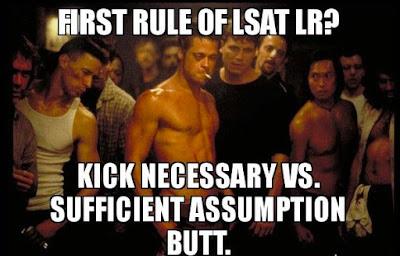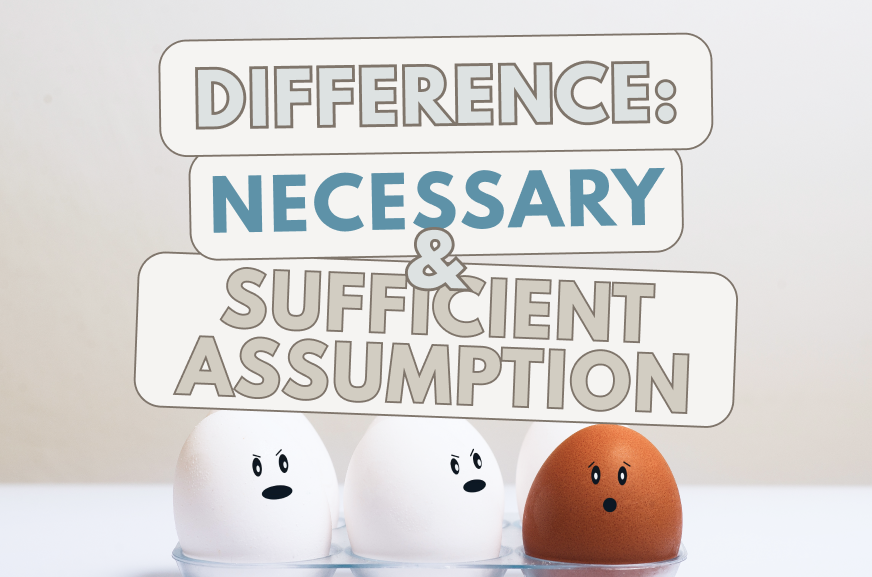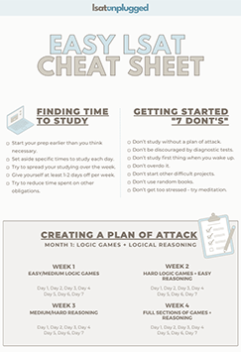Both Necessary Assumption and Sufficient Assumption questions contain the word “assumption” within the question stem. However, they ask for very different things.
(Also see Sufficient Assumption Questions and the Negation Test.)
This is why it’s misleading (and often confusing) to simply refer to both types under the catch-all category of “Assumption” questions.

Others refer to Necessary Assumption questions as “Assumption” questions, and Sufficient Assumption questions as “Justify” questions. However, referring to Sufficient Assumption questions as “Justify” questions is often confusing for test-takers for two major reasons.
Many test-takers mistakenly believe:
- The question stem must contain the word “justify” in order to be a “Justify” question (i.e. they believe the word “justify” is a necessary condition for it to be a sufficient assumption question).
In fact, Sufficient Assumption questions rarely contain the word “justify.”
- Any question stem containing the word “justify” is a “Justify” question (i.e. they believe the word “justify” is a sufficient condition for it to be a sufficient assumption question).
In fact, “Strengthen” and “Strengthen Principle” questions often contain the word “justify” as well.
Basically, the presence of the word “assumption” doesn’t tell you what type of question you’re dealing with, and neither does the word “justify”.
So…how do you tell the difference?
Instead of focusing on the noun “assumption,” focus on the verb in the question stem.
The following indicators are presented in a rough decreasing order of frequency as they appear in PrepTests 50-58, whenever possible. If your materials refer to PrepTests by month and year instead, please see this list.
Necessary Assumption questions often contain the words:
“Depends”
Example #1: “Which one of the following is an assumption that the fund-raiser’s argument depends on?”
(PrepTest 56, Section 3, Question 18)
Example #2: “Which one of the following is an assumption on which the argument depends for its conclusion to be properly drawn?”
(PrepTest 52, Section 1, Question 10)
“Requires”
Example: “Which one of the following is an assumption the bureaucrat’s argument requires?”
(PrepTest 55, Section 3, Question 19)
“Required”
Example: “Which one of the following is an assumption required by the dietitian’s argument?”
(PrepTest 56, Section 2, Question 6)
“Relies”
Example: “Which one of the following is an assumption on which the argument relies?” (PrepTest 56, Section 3, Question 9)
The following three are significantly less common:
“Makes”
Example: “The argument makes which one of the following assumptions?”
(PrepTest 56, Section 2, Question 4)
“Necessary”
Example: “Which one of the following is an assumption necessary for the critic’s conclusion to be properly drawn?”
(PrepTest 55, Section 1, Question 12)
(Granted, the word “necessary” is not a verb, but it’s a pretty telling indicator that this is a necessary assumption question. If you really want a verb there, we could substitute the word “required” for “necessary.”)
“Assumes”
Example: “The argument assumes that”
(PrepTest 30, Section 2, Question 15 – page 58 in Next 10)
Sufficient Assumption questions often contain the words:
“Follows logically if…assumed”
Example #1: “The argument’s conclusion follows logically if which one of the following is assumed?”
(June 2007 LSAT, Section 2, Question 6)
Example #2: “The critic’s conclusion logically follows if which one of the following is assumed?” (PrepTest 56, Section 2, Question 10)
(The above language is an extremely common indicator of sufficient assumption questions, so I’m including two examples. Yes, LSAC can play with the order of words. They do so in the following example as well.)
“Properly inferred if…assumed”
Example: “Which one of the following, if assumed, allows the conclusion of the therapist’s argument to be properly inferred?”
(PrepTest 56, Section 3, Question 16)
“Properly drawn if…assumed”
Example: “The argument’s conclusion is properly drawn if which one of the following is assumed?”
(PrepTest 55, Section 1, Question 4)
“Enables”
Example: “Which one of the following, if assumed, enables the conclusion of the argument to be properly drawn?”
(PrepTest 54, Section 4, Question 22)
“Allows”
Example: “Which one of the following is an assumption that would allow the conclusion above to be properly drawn?”
(June 2007 LSAT, Section 2, Question 15)
“Justifies”
Example: “Which one of the following is an assumption that would serve to justify the conclusion above?”
(PrepTest 4, Section 1, Question 2 in LSAT TriplePrep, Volume 1, one of the books of rare PrepTests.)
***
By the way, here’s how to tell a Strengthen Principle question from a Sufficient Assumption (Justify) question when both contain some version of the word “justify”:
A Strengthen question says something like, “most helps to justify.” The “most helps” part indicates you’re looking to strengthen it — to some degree.
Example #1: “Which one of the following principles most helps to justify the mathematics teacher’s argument?”
(PrepTest 55, Section 1, Question 6)
Example #2: “Which one of the following, if assumed, most helps to justify the reasoning above?”
(PrepTest 50, Section 4, Question 9)
A Sufficient Assumption (Justify) question asks you to “justify the conclusion” – meaning the correct answer will justify it all the way — 100%.
***
Also see: Arguments and Contrapositives | Necessary and Sufficient Assumptions

